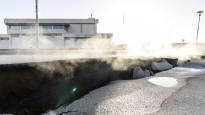The coastal town of Grindavik has been evacuated in case of an eruption.
Elina Sonkajärvi,
Pietu Heiskanen
According to scientists, a volcanic eruption in Iceland on the Reykjanes peninsula is likely.
A postdoctoral fellow from the University of Helsinki’s Department of Geosciences and Geography who visited morning and Ykkösaamu on Tuesday Eemu Ranta said that the style of the potential eruption is typical of the region, but the amount of magma and flow rate differ from previous eruptions in the region.
The beach gave, for example, the Fagradalsfjall volcano in the same area, which has erupted three times in the last two years.
According to Ranta, the eruptions have been unusually small in size and that is why even tourists have been able to see them up close. The current situation seems different.
– In this case, the magma flow rate underground seems to be much higher than before. It’s perhaps a more typical eruption for this area, but it’s no joke when we’re talking about ten times the flow at its worst, Ranta described.
A Finn in Reykjavik: the situation is not much visible
Reykjavik, the capital of Iceland, is located about 40 kilometers from the earthquake zone, but the situation in the city is not much visible, says a professional musician and music producer living in Reykjavik Matt Kallio.
– People feel a lot of empathy towards the residents of Grindavik, because the fate of the city is currently a question mark.
Kallio describes that Icelanders basically have a healthy respect for their environment and nature. Icelanders are actively following the latest developments.
– If a situation arises, we react to it and listen to scientists and authorities, Kallio describes Icelanders’ attitude to the risk of an eruption.
According to Eemu Ranna, the eruption and a certain wind direction can also cause challenges for the residents of the capital.
– Reykjavík is worried about the gases coming with the eruption. We are talking about sulfur dioxide, which when the wind is blowing in the right direction, can drift into the capital region in concentrations high enough to close the windows there, Ranta said.
Ranta estimates that the effects of a possible eruption will remain local to Iceland. The situation is therefore different from, for example, in 2010, when the Eyjafjallajökull volcano erupted, producing a large and high ash cloud and stopping air traffic in the northern hemisphere.
An eruption can start at any time
On Friday, the Reykjanes peninsula was rocked by strong earthquakes, indicating that the probability of a volcanic eruption has increased in the area.
The coastal town of Grindavik, located near the earthquake zone, was evacuated in case of a possible volcanic eruption and a state of emergency was declared in the area. The earthquakes caused subsidence in the city.
According to the Icelandic authorities, there is at least a ten-kilometer-long magma flow under the area, which may erupt to the surface from a crack in the earth’s crust at any time and anywhere. According to information from the Icelandic Meteorological Institute IMO, the magma tunnel extends under the town of Grindavik.
According to Eemu Ranna, this would be a so-called fissure eruption, where magma usually erupts peacefully on the ground. However, according to Ranna, there can be a lot of lava in the eruption.
– That would be enough for such a small bus every second, for several months, Ranta described.
Listen to the entire interview about ‘s morning here:
